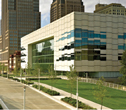Editor's note: The opinions in this article are those of the author's and not NRCA.
To reduce environmental footprints and improve overall building sustainability, building designers are incorporating longer-lasting materials, more energy-efficient assemblies and environmentally conscious technologies.
Roof systems have come under particular scrutiny as they are the first line of defense against the elements and, often, a building envelope's largest exterior surface area. Copper, arguably the most sustainable metal because of its long life cycle, low life cycle costs and recyclability, is not only proving to be a valuable roofing material for its durability and ease of maintenance but also for its energy efficiency and cost effectiveness.
What is cool roofing?
When "cool" roofing is discussed, two main factors usually define the effectiveness of a particular material: reflectance (the ability to reflect solar energy) and emittance (the infrared radiation energy released from the roof). Reflectance and emittance values typically are achieved through paint pigments and reflective coatings in asphalt and other metals.
However, a roof system is more than just its surface material. To achieve the highest potential energy efficiency, a correctly assembled, properly ventilated copper roof system can prove just as effective as a highly reflective or emissive roof.
The CDA study
In a recent study conducted by the Copper Development Association (CDA) at Oak Ridge National Laboratory (ORNL), Oak Ridge, Tenn., two ventilated copper roof systems were compared to two steel roof systems and one asphalt roof system. The ventilated copper roof systems take advantage of convective heating and cooling by properly venting the systems at the eaves and ridges. As air moves in through the eaves, it heats, rises and is expelled through the ventilation at the roof ridge, controlling heat gain and yielding lower attic temperatures, keeping a building cooler and more energy-efficient.
For this study, the reflectance and emittance values were ranked from 10, the highest and best, to 0, the worst. Roof slopes and the roof coverings' ages were taken into account for the measurements. Slopes of 2:12 or less were considered low slope; slopes greater than 2:12 were considered steep slope. The Environmental Protection Agency's ENERGY STAR® program recommends an initial reflectance value of 0.25 for steep-slope roofs with no initial requirement for the emittance value and a three-year aged reflectance value of 0.15.
California's requirements are more complicated and are the toughest in the U.S. Depending on the climate zone, California requires an aged reflectance value of 0.55 and an aged emittance value of 0.75 for low-slope roofs; for steep-slope roofs, an aged reflectance value of 0.15 and aged emittance value of 0.75 are required.
Aged values were recorded for roof coverings at the three-year mark. However, meaningful energy savings for a building cannot be measured simply by a roofing material's reflectance and emittance values. The effect an entire roof system has on the heat gain, cooling load and energy usage of a building and its systems should be evaluated.
Because copper is applied in its natural state, its reflectance and emittance values can vary greatly as a roof ages and changes color. And more important, copper only represents a roof system's outermost layer.

Figure 1: The tested roof assembly
However, all components play a role in the heat gain and loss and energy efficiency of a building being covered. It was for this reason CDA chose to conduct tests evaluating entire roof systems. Previous testing at ORNL revealed by employing the natural convection of heated air below a roof covering, temperatures in an attic space are reduced. Air enters at the eave, is heated by the roof, and, because hot air rises, it is naturally drawn up and vents to the outside. This natural convection controls heat gain and reduces the attic temperature.
The test roof system consisted of a 1 1/2-inch-thick fluted metal roof deck, 3/4-inch-thick oriented strand board underlayment (plywood would work just as well), red rosin paper and standing-seam copper (see Figure 1). Using a fluted metal roof deck was optional; however, similar results can be obtained by using other designs that provide an air space below the deck.
The test roof had a 4:12 slope and faced south. The roof system was compared with control roof systems of typical black asphalt, a typical copper roof assembly and two examples of above-the-sheathing, ventilated stone-coated steel roof systems using cool roof colors.
Study results
Figure 2 shows the ceiling heat flux crossing the attic floors of the respective attic assemblies. The stone-coated metal roof system (SR246E90) dropped the ceiling heat flux by about 29 percent of what the asphalt shingle roof system (SR093E89) measured. The copper roof system with the fluted metal deck dropped peak ceiling heat flux 23 percent more than the coated steel shingle roof system, with a total reduction for the copper roof system at 50 percent of the control asphalt roof system. Peak heat flux dropped an additional 1.5 British thermal units per hour per square foot for the copper roof system as compared with the stone-coated metal roof system.

Figure 2: Heat flux variations of copper vs. asphalt and stone-coated steel
By incorporating intelligent design elements, such as the tested vented roof system, building heat gain and loss for the resulting building's energy performance can be better addressed without solely relying on a roof covering's inherent surface reflectance and emittance.
In this case, copper performs well and emerges as the better choice, allowing building designers to provide a high-efficiency roof system with a design aesthetic that weathers the test of time. In the end, the result is a beautiful building with reduced electrical energy usage and lower cooling costs for the building owner.
The bottom line
The bottom line is copper has been providing property owners with a sustainable roof system design for hundreds of years. The recyclability, long life span, beauty and maintenance-free durability of a properly designed copper roof system can meet or exceed the typical installations of other comparable materials and be one of the most environmentally sound assets of your green building.
Based on performance and overall goals, a copper roof system can be cool where it matters most: energy savings. Not only does copper's versatility provide various ways to address today's energy concerns, its durability and longevity are essential to long-term cost effectiveness.
Andy Kireta Jr. is vice president of market development for the Copper Development Association.
To learn more about copper and cool roofing, visit www.copper.org.
Did you know?:
The NRCA Roofing Manual: Metal Panel and SPF Roof Systems—2012 contains design guidelines for copper and other metals commonly used in metal panel roof systems.



